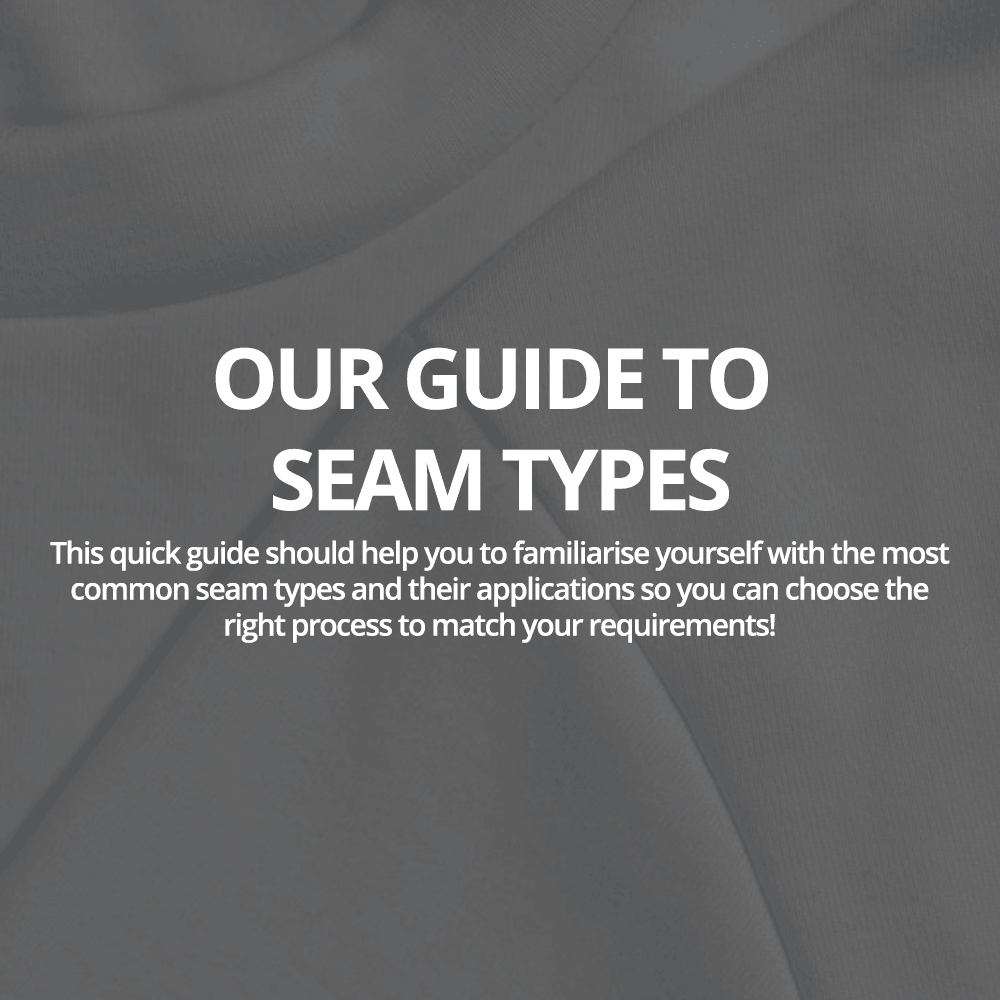Our quick guide to seam types
Put simply, a seam is where two or more layers of material are joined together with stitches. Seams are described as either flat, superimposed, lapped, bound, or ornamental, and each differs in appearance and physical properties. Seams produced by industrial sewing machines are used across a wide range of apparel and non-apparel applications to hold together everything from t-shirts to tents! Choosing the correct seam type ensures that your finished product stays together and is fit for purpose.

The different types of seams are separated into these main classes:
Class 1 – Superimposed seams
Class 2 – Lapped seams
Class 3 – Bound seams
Class 4 – Flat seams
Class 5 – Decorative/ornamental stitching
Class 6 – Edge finishing/neatening
Class 1 – Superimposed seams
Superimposed seams are simple to sew and are commonly used for a wide range of applications, including apparel such as lingerie and shirts.
These seams are created when two or more pieces of material are layered over one another and joined near an edge with one or more rows of stitches. The work is usually then turned inside out to conceal the stitches and ends of the fabric to create a neat finish.
Within this class, different seam variations are created depending on the stitch type used. A superimposed seam can be sewn with a 301 stitch (standard lockstitch) or 401 (2 thread chainstitch) to create a simple seam.
This type of seam can also be sewn with a 500 (overlock) stitch, or with combination stitches such as a 516 (safety stitch) to create tidy, load bearing seams.

Class 2 - Lapped seams
Lapped seams are created by joining two or more layers of material with the edges overlapped or folded. This can be done with one of more rows of stitches. There are 2 common variations: the Lap Felled type, and French seams.
The Lap Felled type are strong seams which protects the fabric edges from fraying. They are formed with one stitching operation and are commonly used for making garments such as jeans. It is normally sewn using a 401 chainstitch.
French seams are flat, folded seams which involve two stitching operations but only have one row of stitching visible on the top surface. They are commonly used for producing rainwear and edge stitching front facings on jackets and dresses.

Class 3 – Bound seams
Bound seams are formed by folding a binding strip over the edge of the material. Both edges of the binding are then joined to the material with one or more rows of stitching. This produces a neat edge over a seam which would otherwise look unsightly and be exposed to wear. They are most commonly seen on the necklines of t-shirts.
These seams are usually sewn with a 401 (chainstitch) or a 301 (lockstitch).

Seam class 4 – Flat seams
Flat seams (sometimes called butt seams) are formed when two fabric edges (flat or folded) are brought together and oversewn with a zig zag lockstitch (304), chainstitch (401) or a coverstitch (class 600). They are used to produce a join without creating any bulk on the fabric, particularly with underwear or fine knitted garments. The edges of the material don’t overlap, thus the name flat seam. The looper thread(s) must be soft yet strong, and the covering thread is often intended to be decorative as well as secure.

Seam class 5 – Decorative/ornamental seams
Decorative seams are formed on a single layer of material using a series of stitches along a straight or curved line or following an ornamental design. More complex variations include various forms of piping which produce a raised line along the fabric surface. This type of seam is used to create decorative effects.

Seam class 6 – Edge finishing/neatening
This seam type is simply the finishing of the edge of a single ply of material by folding it or covering it with a stitch. This is often achieved by serging with an overlocker. This method reinforces a cut edge with overedge stitching to neaten it and prevent fraying. This seam type includes other popular methods of producing a neat edge such as hemming and blind stitch hemming.

No matter what type of item you’re looking to produce or which type of seam it requires, we can supply you with the perfect industrial sewing machine! All our machines are delivered to you fully built, set up, and ready to use. For more information please contact our team via the contact form on the website or by emailing info@ae-sewingmachines.co.uk
